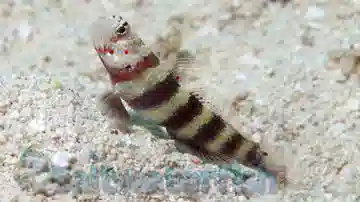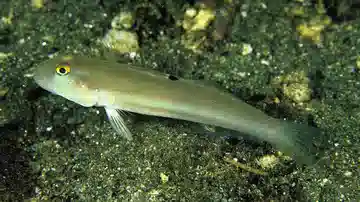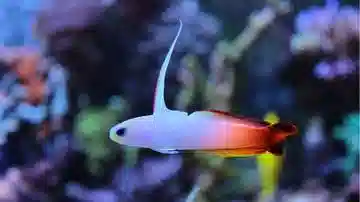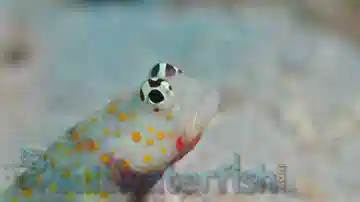Orange Spotted Shrimpgoby
Amblyeleotris guttata
(20 Reviews)
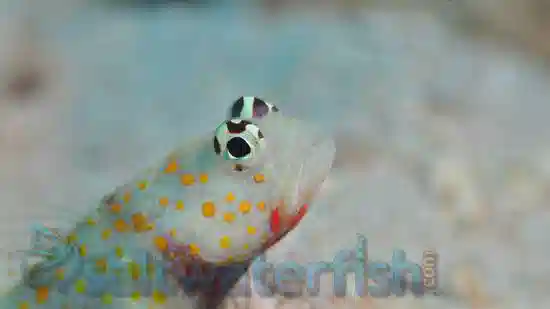
Orange Spotted Shrimpgoby
Amblyeleotris guttata
(20 Reviews)
{{ item.name }}
Size: {{ item.extra_field_3 }}
${{ getFormattedPrice(item.saleprice) }} ${{ getFormattedPrice(item.price) }}
To join the waiting list, click here
Free Shipping
With
$199.00
or more in Marine Life.
More details...
Orange Spotted Shrimpgoby Care Facts
| Care Level: | Easy |
|---|---|
| Temperament: | Peaceful |
| Diet: | Carnivore |
| Reef Safe: | Yes |
| Minimum Tank Size: | 10 gallons |
| Max Size: | 4 inches |
Orange Spotted Shrimp Goby (Amblyeleotris guttata): A Comprehensive Guide for Saltwater Marine Aquariums
The Orange Spotted Shrimp Goby, scientifically known as Amblyeleotris guttata, is a captivating and intriguing species that has found its way into the hearts of marine aquarium enthusiasts. This informational guide offers valuable insights into the Orange Spotted Shrimp Goby, including its habitat, reef compatibility, size, lifespan, dietary requirements, aquaculture availability, sexual dimorphism, and more. Whether you're an experienced aquarist or a beginner, this information will assist you in making informed decisions about keeping this species in your saltwater aquarium.
Habitat of the Orange Spotted Shrimp Goby
The Orange Spotted Shrimp Goby is native to the Indo-Pacific region, specifically found in the waters of the Indian Ocean and the western and central Pacific Ocean. They inhabit sandy bottoms in the wild, often near coral reefs or rocky outcrops. They are well-known for their fascinating symbiotic relationship with certain species of shrimp.
Reef Compatibility of the Orange Spotted Shrimp Goby
Orange Spotted Shrimp Gobies are considered reef-safe, which means they are compatible with coral and other invertebrates in a reef aquarium. They do not exhibit destructive behaviors that could harm corals or the reef structure. Their presence can be beneficial as they help aerate the sandbed through their burrowing activities.
Size and Lifespan of the Orange Spotted Shrimp Goby
These shrimp gobies are relatively small and reach a maximum size of about 3 inches (7.5 centimeters) when fully grown.
Lifespan and Diet of the Orange Spotted Shrimp Goby
With proper care, Orange Spotted Shrimp Gobies can live for several years in captivity. They have an average lifespan of 3 to 5 years. Orange Spotted Shrimp Gobies have a mutualistic relationship with pistol shrimp in their natural habitat. The shrimp create and maintain burrows, which provide shelter for both species. The gobies act as sentinels, warning the shrimp of potential threats, while the shrimp maintain the burrow. It's essential to replicate this relationship in captivity by keeping them with a compatible pistol shrimp species. Additionally, feed them a diet consisting of high-quality marine pellets, frozen foods like mysis shrimp and brine shrimp, and occasionally live foods to meet their nutritional needs.
Sexual Dimorphism in the Orange Spotted Shrimp Goby
Orange Spotted Shrimp Gobies do not exhibit significant sexual dimorphism, making it challenging to distinguish between males and females visually. Both sexes share similar coloration and characteristics.
Symbiotic Relationships of the Orange Spotted Shrimp Goby
One of the most remarkable aspects of Orange Spotted Shrimp Gobies is their unique symbiotic relationship with pistol shrimp (Alpheus spp.). This relationship is mutualistic, benefiting both species. The gobies watch for potential predators while the shrimp maintain and expand their shared burrow. This cooperative behavior enhances the safety and living conditions for the gobies and the shrimp.
Juvenile vs. Adult Coloration of the Orange Spotted Shrimp Goby
Juvenile and adult Orange Spotted Shrimp Gobies share similar coloration. They have a pale white to light cream body adorned with distinct orange spots, which lend them their common name.
Compatibility and Temperament of the Orange Spotted Shrimp Goby
When considering Orange Spotted Shrimp Gobies for your saltwater aquarium, compatibility with other tank inhabitants is crucial to creating a harmonious community. They are generally peaceful, making them suitable for community aquariums.
Suitable Tank Mates for the Orange Spotted Shrimp Goby
Here are five compatible tank mates that can coexist peacefully with Orange Spotted Shrimp Gobies:
- Pistol Shrimp (Alpheus spp.): This is the ideal tank mate, as they form a natural and mutually beneficial partnership.
- Firefish Gobies (Nemateleotris spp.): Peaceful and colorful, Firefish gobies are excellent companions.
- Blennies (Ecsenius spp.): Blennies are known for their quirky personalities and adapt well to community aquariums.
- Dwarf Angelfish (Centropyge spp.): Dwarf angelfish are compatible if introduced carefully and monitored for any signs of aggression.
- Dartfish (Ptereleotris spp.): Dartfish are peaceful and come in various vibrant colors.
Tank Requirements for the Orange Spotted Shrimp Goby
Minimum Aquarium Size: A tank with a capacity of at least 10 gallons is suitable for keeping Orange Spotted Shrimp Gobies and their pistol shrimp partner. Providing ample substrate (sand) is essential, allowing them to dig and create burrows.
Aquascaping: Create a well-structured aquascape with a sandy substrate, live rock, and open spaces. Ensure that the tank has a secure lid to prevent jumpers.
Water Conditions for the Orange Spotted Shrimp Goby
Maintain stable water parameters with the following guidelines:
- pH: Maintain a stable pH level between 8.1 and 8.4.
- Salinity: Keep the salinity within the range of 1.023 to 1.025.
- Water Temperature: The recommended temperature range is 72°F to 78°F (22°C to 26°C).
- Water Flow: Moderate water flow is suitable, as it mimics their natural habitat.
Why Choose the Orange Spotted Shrimp Goby from Saltwaterfish.com
Purchasing Orange Spotted Shrimp Gobies from Saltwaterfish.com ensures you receive healthy and responsibly collected specimens from reputable sources. We prioritize the well-being of marine life and provide top-quality fish that are carefully selected and handled to ensure a smooth transition to your aquarium. Orange Spotted Shrimp Gobies, with their captivating behavior and unique partnership with pistol shrimp, are a fascinating addition to any saltwater aquarium. Acquiring them from a reliable source can enhance your aquarium's biodiversity while supporting ethical and responsible marine life acquisition.
In summary, the Orange Spotted Shrimp Goby, with its captivating appearance and intriguing behavior, is an excellent choice for a saltwater marine aquarium. They can thrive and add a touch of wonder to your underwater world when provided with suitable tank conditions, compatible tank mates, and a shrimp partner. Remember that maintaining stable water parameters and providing proper care are essential for the well-being of these remarkable creatures in captivity.
Reviewed by: Olena Makogon on Nov. 10, 2025
Reviewed by: John Arcuri on Oct. 10, 2025
Reviewed by: Starcen Ellis on June 11, 2025
Reviewed by: Francisca Lashley-Hunt on April 27, 2025
Reviewed by: Jennifer Sanchez on Dec. 16, 2024
Nice fish, good color
Reviewed by: Shaun Huddleston on Dec. 8, 2024
Has acclimated great
Reviewed by: Jose Lara on Dec. 1, 2024
Reviewed by: Brian Carr on Nov. 20, 2024
Great addition, they hang around the bottom. Looking forward to see them sift the sand in their mouths.
Reviewed by: Jose Lara on Oct. 8, 2024
Reviewed by: Mark Goldstein on Oct. 8, 2024
Alive
Reviewed by: Jochen Renz on Oct. 6, 2024
He likes to hide and almost like he is playing peekaboo, especially at feeding time.
Reviewed by: William Brooks on July 18, 2024
Reviewed by: Debbie Konechney on March 19, 2024
Reviewed by: Paul Pronsati on Feb. 19, 2024
Reviewed by: Chadwick Adams on Feb. 18, 2024
Good color and health. Always visible, but not very active even though they look very healthy
Reviewed by: William Hopper on Jan. 18, 2024
Reviewed by: Barbara Macey on Nov. 27, 2023
Reviewed by: Paul Pronsati on Oct. 30, 2023
Love them.
Reviewed by: Jerry Albright on Aug. 28, 2023
Arrived healthy with great color. Took a couple days to acclimate to his new environment and start eating mysis. Two weeks in and seems to be settling in well. Adorable fish who likes to "hop" around the tank.
Reviewed by: David S on June 5, 2017


